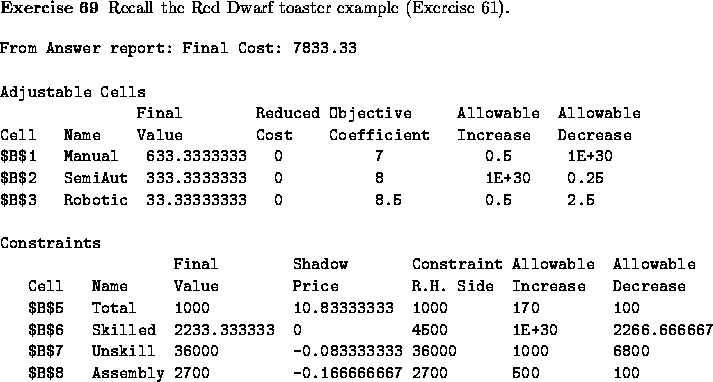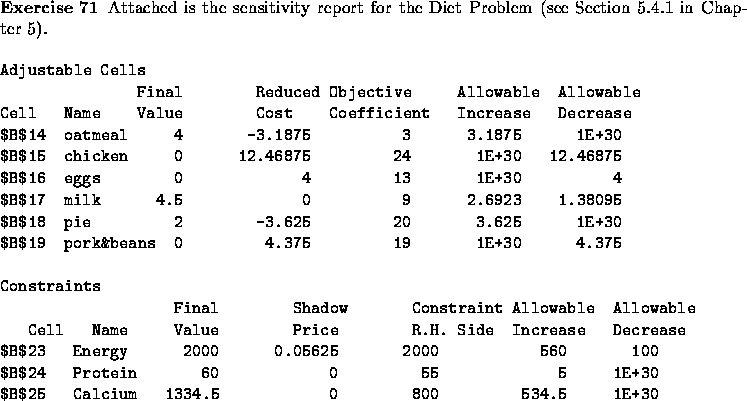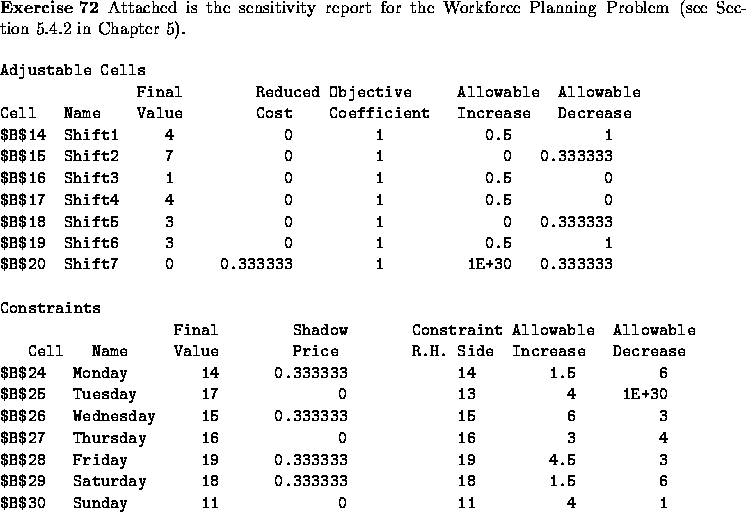

(a) What is the optimal allocation of production? What is the average cost/toaster of production.
(b) By how much can the cost of robots increase before we will change that production plan.
(c) How much is Red Dwarf willing to pay for more assembly room time? How many units is Red Dwarf willing to purchase at that price?
(d) How much will we save if we decide to produce only 950 toasters?
(e) A new production process is available that uses only 2 minutes of skilled labor, 10 minutes of unskilled labor, and an undetermined amount of assembly floor time. Its production cost is determined to be $10. What is the maximum assembly floor time that the process can take before it is deemed too expensive to use?
Answer:
(a) 633.3 should be produced manually, 333.3 should be produced semiautomatically, and 33.3 produced robotically, for an average cost of $7.383/toaster.
(b) It can increase by $0.50.
(c) Value is $0.16/minute, willing to purchase 500 at that price.
(d) Objective will go down by 50(10.833).
(e) Cost of $10 versus marginal cost of $10.833, leave 0.83. Unskilled labor costs $0.0833/unit. Therefore, if the new process takes any time at all, it will be deemed too expensive.

The resulting linear program and Solver output is attached:
MAX 150 RIDE + 200 FOOD + 300 SHOP
SUBJECT TO
RIDE + FOOD + SHOP <= 50
SHOP <= 10
20 RIDE + 30 FOOD >= 1000
3 RIDE + 6 FOOD + 5 SHOP <= 200
-------------------------------------------------------------------
Answer report:
Target Cell (Max)
Cell Name Original Value Final Value
$B$5 Cost 0 9062.5
Adjustable Cells
Cell Name Original Value Final Value
$B$1 Ride 0 31.25
$B$2 Food 0 12.5
$B$3 Shop 0 6.25
Constraints
Cell Name Cell Value Formula Status Slack
$B$6 Land 50 $B$6<=$D$6 Binding 0
$B$7 ShopLim 6.25 $B$7<=$D$7 Not Binding 3.75
$B$8 Trees 1000 $B$8>=$D$8 Binding 0
$B$9 Workers 200 $B$9<=$D$9 Binding 0
-----------------------------------------------------------------------------
Sensitivity report:
Adjustable Cells
Final Reduced Objective Allowable Allowable
Cell Name Value Cost Coefficient Increase Decrease
$B$1 Ride 31.25 0 150 83.33333333 76.6666667
$B$2 Food 12.5 0 200 115 125
$B$3 Shop 6.25 0 300 1E+30 116.666667
Constraints
Final Shadow Constraint Allowable Allowable
Cell Name Value Price R.H. Side Increase Decrease
$B$6 Land 50 143.75 50 10 16.66666667
$B$7 ShopLim 6.25 0 10 1E+30 3.75
$B$8 Trees 1000 -4.375 1000 166.66667 100
$B$9 Workers 200 31.25 200 30 50
For each of the following changes, either find the answer or state that the information is not available from the Solver output. In the latter case, state why not.
(a) What is the optimal allocation of the space? What is the profit/hour of the park?
Optimal Allocation: Profit/hour:
(b) Suppose Food only made a profit of $180/hour. What would be the optimal allocation of the park, and what would be the profit/hour of the park?
Optimal Allocation: Profit/hour:
(c) City Council wants to increase our tree requirement to 1020. How much will that cost us (in $/hour). What if they increased the tree requirement to 1200?
Increase to 1020: Increase to 1200:
(d) A construction firm is willing to convert 5 acres of land to make it suitable for shops. How much should Kennytrail be willing to pay for this conversion (in $/hour).
Maximum payment:
(e) Kennytrail is considering putting in a waterslide. Each acre of waterslide can have 2 trees and requires 4 workers. What profit/hour will the waterslide have to generate for them to consider adding it?
Minimum Profit: Reason:
(f) An adjacent parcel of land has become available. It is five acres in size. The owner wants to share in our profits. How much $/hour is Kennytrail willing to pay?
Maximum payment:

Answer each of the following questions independently of the others.

Answer each of the following questions independently of the others.